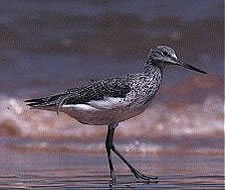Wildlife |
34 species of wading bird have been recorded from Towra Point. Towra Point progressivly become one of the most important breeding sites for little turns on the Australian east coast |
Long distance voyagers
A complete list of migratory and resident waders covered under the JAMBA & CAMBA treaties and Threatened Species Conservation Act can be found here. |
Conservation
NPWS have been managing Spit Island as a Little Turn breeding site since 1992 |
|
| Wading birds such as the Greenshank pictured below prefer a combination of sand and mud, which supports small invertebrates such as worms, crabs and shellfish on which the birds feed. Some birds probe deeply into the sediment, others take food from the surface. Feeding differences are reflected in the shapes and lengths of their bills. Some waders use their bills to turn over shells, stones and seaweed in search of food. They are equipped with semi-webbed feet with long toes adapted for walking on soft sediments and have long legs compared with body size. |
 |
Most birds in the Towra Point/Botany Bay area are associated with wetlands, their preferred feeding habitat being intertidal beach zones, sandspits, tidal mudflats and saltmarsh. Some of the birds that feed on the intertidal flats migrate over 12,000 kilometres from as far away as Siberia, China and Japan. These include the endangered little tern (Sterna albifrons). The smallest is the red-necked stint (Calidris rufficollis), only 15cm long and a summer visitor from north-eastern Siberia and north-western Alaska. The largest is the eastern curlew (Numenius madagascariensis), with a length of 65 cm. It is a regular spring and summer migrant from north-eastern Siberia. Recently the adjacent Taren Point mudflats have also become a significant feeding area for waders. Indeed that area and the birds who use it have recently been declared as an endangered ecological community by the NSW Scientific Committee.
Towra Point is also used by many non-migratory waders, such as the pied oyster-catcher (Haematopus longirostrus).
The little tern nests on low areas of sand and shingle. Spit Island adjacent to Towra Point is one of the most important remaining nesting sites for little terns in New South Wales.
Critical Habitat Features for Wading Birds |
Feeding
-
Larger than 3 ha in area
-
Within 1 km of other wader habitats
-
Bare shallow foreshores fringed by mature mangrove forests with canopy 1-4m high
-
Low and wet rather than high and dry, salinity 8-40g/L
-
Loamy sand substrates
-
Saltmarsh (insects)
|
Roosting
-
Bare shallow foreshores
-
Fringing mangroves (not too close)
-
Free from structures, rocks
-
Islands, shorelines, points and veg. peninsulas are best
-
Mainlands with buffer of undeveloped land OK
|
|
| top of page |



